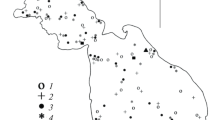Summary
Temperature and dissolved oxygen content measured weekly at various depths during 3 1/2 years in the filling phase of a tropical man-made lake, show that at the dam-site fluctuations of epilimnion values occurred, whereas the hypolimnion remained almost constant in temperature and permanently devoid of oxygen. This confirms previous reports concerning another mid-lake station. Apart from rather steep superficial temperature gradients, classical thermoclines did not occur. It is proposed that the lake could not become fully mixed by wind action because of the great vertical density differences at the prevailing temperatures, and because of the drowning forest still giving shelter by the extending crowns. On the other hand, the stratification was not static. Fluctuations between high and low epilimnion values for temperature, oxygen content and transparency oocurred yearly, but could not be related satisfactorily to the prevailing seasons. The depth of the epilimnion increased each year. It is suggested that the observed kind of stratification was effective though not absolute. Vertical exchange may have been reduced by increasing density differences, but it was not fully eliminated. This explains the varying degree of incorporation of upper hypolimnetic layers in the epilimnion in relation with epilimnetic temperature. Comparison with large African reservoirs accentuates the exceptional limnological development of Lake Brokopondo during ifs filling phase.
Similar content being viewed by others
References
ACKERMANN, W. C., G. F. WHITE and E. B. WORTHINGTON (eds.), 1973. Man-made lakes: Their problems and environmental effects. Geoph. Mon., 17. Washington D.C., XVI+847 pp.
ANONYMUS, 1968. Klassificatie der seizoenen. Meteorologische Dienst, Paramaribo, Serie 2, no. 6, 13 pp.
ANONYMUS, 1970. Quality and availability of riverwater in the coastal area of Surinam. 9. Hydrological data lower Suriname River. Hydraulic Research Division, Ministry of Public Works and Traffic, Paramaribo, 175 pp.
BALON, E. K. and A. G. COCHE, 1974 Lake Kariba, a man-made tropical ecosystem in Central Africa. The Hague, XII+767 pp.
BEADLE, L. C., 1966. Prolonged stratification and deoxygenation in tropical lakes. I. Crater Lake Nkugute, Uganda, compared with lakes Bunyoni and Edward. Limnol. Oceanogr. 2: 152–163.
BEADLE, L. C., 1974. The inland waters of tropical Africa. London, VIII+365 pp.
BISWAS, S., 1973. Limnological observations during the early formation of Volta Lake in Ghana. Geoph. Mon., 17: 121–128.
DENNY, P., 1972. The significance of the pycnocline in tropical lakes. Afr. J. Trop. Hydrobiol. Fish., 2: 85–89.
EWER, D. W., 1966. Biological investigations on the Volta Lake, May 1964–May 1965. In: Lowe-McConnel, R. H. (ed.). Man-made lakes, 21–31. London, 218 pp.
GLIWICZ, Z. M., 1976. Stratification of kinetic origin and its biological consequences in a neotropical man-made lake. Ekol. Pol., 24: 197–209.
HEIDE, J. VAN DER, (in press). Stability of diurnal stratification in the forming Brokopondo reservoir in Suriname, S. America. Verh. Internat. Verein. Limnol., 20: 1702–1709.
HEIDE, J. VAN DER, P. LEENTVAAR and J. MEYER, 1976. Hydrobiology of the man-made Brokopondo Lake. In: Westermann, J. H., L. J. van der Steen and P. Wagenaar Hummelinck (eds.), Brokopondo Research Report, Suriname, Part II. Uitgaven Natuurwetenschappelijke Studiekring voor Suriname en de Nederlandse Antillen (Found. Sci. Res. Surinam and Neth. Ant.), Utrecht, no. 90, 95 pp.
HUTCHINSON, G. E., 1957. A treatise on Limnology. Vol. I. New York, XII +1015 pp.
LAWSON, G. W., T. PETR, S. BISWAS E. R. I. BISWAS and J. D. REYNOLDS, 1969. Hydrobiological work of the Volta Basin Research Project 1963–1968. Bull. I. F. A. N., 31, Sér. A(3): 965–1003.
LEENTVAAR, P., 1966. The Brokopondo Research Project, Surinam. In: Lowe-McConnell, R. H. (ed.). Man-made lakes, 33–42. London, 218 pp.
LEENTVAAR, P., 1973. Lake Brokopondo, Geoph. Mon., 17: 186–196.
LEENTVAAR, P., 1975. Hydrobiological observations in Surinam with special reference to the man-made Brokopondo Lake. Studies Fauna Suriname, 15: 1–173.
PAIVA, M. P., 1977. Algumas consideracoes sobre a represa de Brokopondo (Suriname). Eletrobrás, Centrais Elétricas Brasileiras S. A., Rio de Janeiro, 61 pp.
RUTTNER, F., 1931. Hydrographische und hydrochemische Beobachtungen auf Java, Sumatra und Bali. In: Thienemann, A., (ed.). Tropische Binnengewässer, Ergebnisse einer ... limnologischen Forschungsreise, Bd. I. Arch. Hydrobiol., Suppl. 8: 197–454.
RUTTNER, F., 1937. Stabilität und Umschichtung in tropischen und temperierten Seen. Arch. Hydrobiol., Suppl. 15: 178–186.
VINER, A. B., 1970. Hydrobiology of Lake Volta, Ghana. I. Stratification and circulation of water. Hydrobiologia, 35: 209–299.
WALKER, K. F. and G. E. LIKENS, 1975. Meromixis and a reconsidered typology of lake circulation patterns. Verh. Internat. Verein. Limnol. 19: 442–458.
ZAGO, M. S. A., 1976. The planktonic Cladocera (Crustacea) and aspects of the eutrophication of Americana Reservoir, Brazil. Bol. Zool., Univ. S. Paulo, 1: 105–145.
Author information
Authors and Affiliations
Rights and permissions
About this article
Cite this article
Van Der Heide, J. Stratification in the filling phase of the man-made lake Brokopondo in Surinam (S. America). Hydrobiological Bulletin 12, 85–98 (1978). https://doi.org/10.1007/BF02260709
Issue Date:
DOI: https://doi.org/10.1007/BF02260709




